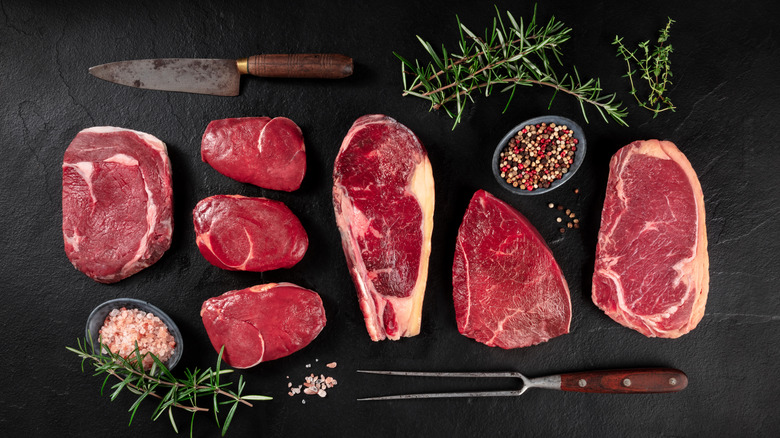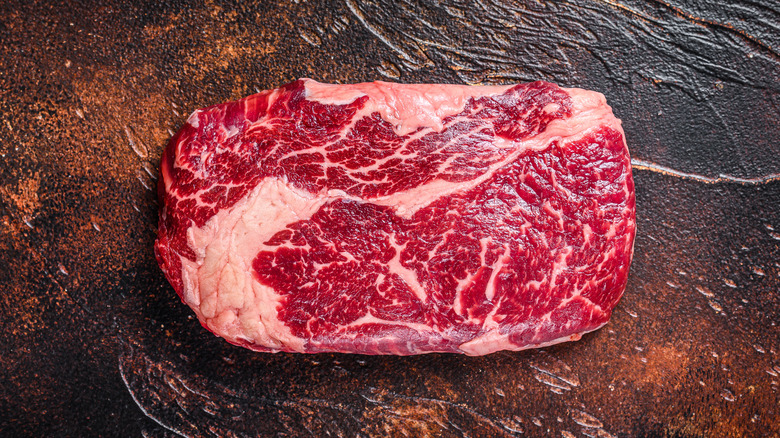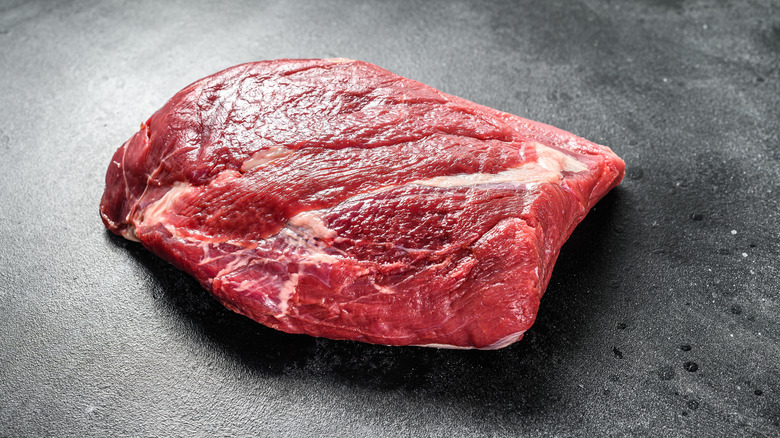Why You Shouldn't Cook Some Cuts Of Steak On The Grill
We may receive a commission on purchases made from links.
Steak is an indulgence, and you'll probably have to drop a little extra dough at the grocery store if that's what you want. You don't have to go to the extreme, of course, unless you're eating at Wally's Wine and Spirits in Las Vegas, which sells a 60-ounce porterhouse steak for $20,000, according to Rarest. At about $5,333 per pound, it is the most expensive meat in the world. This is obviously an extreme example, but it highlights the fact that many cuts of steak are considered luxury items in many people's eyes. However, this isn't the case for all cuts of beef, and there is a pretty simple reason for that.
According to SteakSpecialist, the most prized cuts of beef compose just 8-10% of the carcass. As with most things, scarcity leads to a higher price tag. However, it would be both wasteful and disrespectful to discard the other 90% of the cow, and there are many delicious cuts in there that just don't happen to be as prized by butchers. That doesn't mean you should avoid them though, in fact, this is often where you'll find the best deals. Any cut of beef can be made delicious if you cook it right, and while we often think of steaks as a grilling go-to, there are a number of cuts that are better suited for other cooking methods.
Fattier cuts are best for the grill
The best types of steak for grilling are typically those with ample marbling, meaning they have a good degree of intramuscular fat. As Insider explains, fat adds flavor and moisture to the meat, helping it to stay tender. Thanks to their extra-juicy nature, these steaks are very forgiving, i.e. difficult to overcook, and they are perfectly suited for the high heat of the grill. Some popular examples of well-marbled cuts are ribeye, top sirloin, T-bone, porterhouse, and New York strip steaks, via Taste of Home.
In general, fattier steaks are better for grilling, but there is one notable exception: the filet mignon. As MasterClass explains, the filet mignon is a small medallion of meat taken from the short end of a beef tenderloin. The tenderloin is a long muscle positioned near the cow's spine, and because it hardly gets any exercise, it has soft, small muscle fibers, making it particularly tender. However, the near-total lack of fat makes it one of the least flavorful pieces of beef.
Lean cuts should be cooked low and slow
With the exception of filet mignon, lean cuts of beef shouldn't go on the grill as high heat will turn them tough and dry. Taste of Home lists brisket, chuck, and rump roast as popular examples. These cuts are so tough because they comprise muscles, which are consistently in use. For example, chuck comes from the cow's shoulder, so it gets a heavy workout every day. Steak School suggests slow-cooking these cuts at a low temperature. Prolonged exposure to low heat will cause the connective tissue within the muscle to break down. The main type of connective tissue you need to worry about is called collagen. It toughens up when exposed to the high heat of a grill, but breaks down into tender, juicy gelatin if you slow-cook it.
A slow cooker, such as a crock pot, is the perfect kitchen gadget for turning lean cuts into tender and juicy meals. However, there are other low-and-slow methods that you can use if you don't have a dedicated slow cooker. The Washington Post wisely points out that a long stint in an oven set to a low temperature will do the trick perfectly. This is what braising is all about. If you're really craving the smoky, woodsy flavor obtained by grilling, you can slow-cook beef in a smoker. If you don't own a dedicated smoker, you can approximate the experience by making an indoor smoker from a pressure cooker or a Dutch oven.


